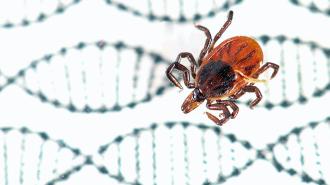CRISPR is now a potential weapon in the fight against tick-borne diseases, thanks to a team of U.S. researchers that has created two new ways to hack into tick embryos.
“This is the first study to demonstrate that genetic transformation in ticks is possible by not only one, but two different methods,” research leader Monika Gulia-Nuss of the University of Nevada, Reno, told GEN News.
“Ticks are a formidable foe to public health.”
Jason Rasgon
Why it matters: There are more than ten different tick-borne diseases, including Rocky Mountain spotted fever, which can kill a person within days if left untreated. Lyme disease is the most common, though, with about 300,000 cases reported in the U.S. every year.
It’s getting progressively harder to prevent ticks from spreading these diseases, too, as climate change causes milder winters and longer warm seasons that allow the arachnids to survive in areas that were previously inhospitable.
“Ticks are a formidable foe to public health,” researcher Jason Rasgon from Penn State said in a press release. “We are in desperate need of new tools to fight ticks and the pathogens they spread.”
The idea: CRISPR is an attractive solution to the problem of tick-borne diseases.
After figuring out what genetic edits would prevent ticks from being able to harm people — making ticks immune to Lyme bacteria, for instance, or unable to bite people — researchers could edit groups of them in a way that ensures changes are passed down to future generations.
Those ticks could be released into the wild, breeding with and taking over the wild populations.
Ticks eggs are coated in a hard wax that can literally shatter the glass needles used for CRISPR injections.
The challenge: This approach is already being applied to malaria-transmitting mosquitoes, but scientists have run into a wall trying to use CRISPR to prevent tick-borne diseases — or, more accurately, a hard shell.
The problem is that scientists need to be able to insert their CRISPR system into ticks when they’re at the embryo stage. But ticks grow in eggs coated in a hard wax, which can literally shatter the glass needles used for injections.
“Previously, no lab has demonstrated genome modification is possible in ticks,” Gulia-Nuss said. “Some considered this too technically difficult to accomplish.”
The research: Gulia-Nuss’ team, which also includes researchers from the University of Maryland, has now demonstrated two different techniques that make gene editing a viable option for fighting tick-borne diseases.
“Some considered genome modification in ticks too technically difficult to accomplish.”
Monika Gulia-Nuss
For the first, they physically removed the gland that produces the wax coating from female ticks. This caused the animals to lay eggs without the wax. The researchers were then able to use CRISPR to make deletions in two different genes in the tick embryos.
For the second, they used a novel technology developed by Rasgon to inject a CRISPR system directly into female ticks first and have it target the cells in their ovaries, resulting in edits to their offspring.
The big picture: So far, all we know is that it’s possible to get a CRISPR system into ticks — we still don’t know what edits, if any, can prevent the spread of tick-borne diseases.
Once we figure that out, we then need to be certain that releasing ticks with those edits isn’t going to negatively affect the greater ecosystem in some way — because once the edited arachnids are in the wild, we probably won’t be able to stop their spread, although scientists are also working on several ideas that could reverse genetic changes.
We’d love to hear from you! If you have a comment about this article or if you have a tip for a future Freethink story, please email us at [email protected].






